Credit cards
College is an essential period of preparation: You gain knowledge, skills, experience, and credentials to help you succeed in the years ahead. And just as a degree can enhance your job prospects, a student credit card can help you take important steps toward long-term financial stability.
We analyzed student credit cards available from major credit card issuers, comparing them to a range of relevant criteria.
| Student Credit Card | Variable APR | Benefits | Get Started |
|---|---|---|---|
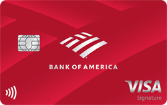
Bank of America® Customized Cash Rewards Credit Card See Student Credit Cards Fact Sheet |
13.99% to 23.99% variable APR |
|
|
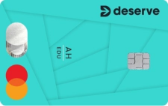   Deserve® EDU Mastercard for Students See Student Credit Cards Fact Sheet |
18.74% variable rate |
|
|
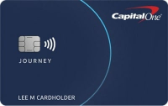   Journey Student Rewards Cards from Capital One See Student Credit Cards Fact Sheet |
26.99% variable APR |
|
|
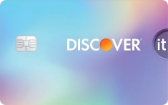   Discover it® Student Cash Back See Student Credit Cards Fact Sheet |
0% intro APR for the first six months After the first six months, you’ll receive a variable APR ranging from 12.99% to 21.99% based on your creditworthiness. |
|
|
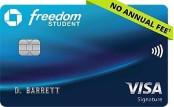   Chase Freedom® Student Card See Student Credit Cards Fact Sheet |
14.99% variable rate |
|
|
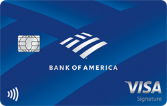   Bank of America® Travel Rewards Credit Card for Students See Student Credit Cards Fact Sheet |
13.99% - 23.99% variable APR |
|
|
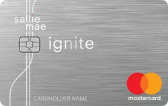   Sallie Mae Ignite℠ Card See Student Credit Cards Fact Sheet |
12.99% to 24.99% variable APR |
|
|
   Sallie Mae Accelerate℠ Card See Student Credit Cards Fact Sheet |
12.99% to 24.99% variable APR |
|
|
   Sallie Mae Evolve℠ Card See Student Credit Cards Fact Sheet |
12.99% to 24.99% variable APR |
|
|
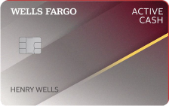   Wells Fargo Active Cash℠ Card See Student Credit Cards Fact Sheet |
14.99%, 19.99%, or 24.99% variable APR |
|
|
   The Petal 1 Visa Card See Student Credit Cards Fact Sheet |
19.99% - 29.49% variable APR |
|
|
   The Petal 2 Visa Card See Student Credit Cards Fact Sheet |
12.99% - 26.99% variable APR |
|
|
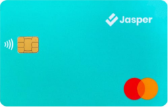   Jasper Cash Back Mastercard® See Student Credit Cards Fact Sheet |
15.49% - 24.99% variable APR |
|
|
   Upgrade Card See Student Credit Cards Fact Sheet |
8.99% - 29.99% fixed APR (though Upgrade reserves the right to adjust your rate under certain circumstances, such as if your credit score changes) |
|
|
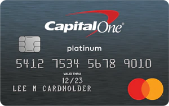   Secured Mastercard® from Capital One See Student Credit Cards Fact Sheet |
26.99% Variable APR |
|
|
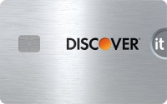   Discover it® Student Chrome See Student Credit Cards Fact Sheet |
0% APR for the first six months after account opening, 12.99% to 21.99% after that |
|
Student Credit Cards:
Everything You Need to Know
Student credit cards allow you to begin building your credit by establishing a track record of responsible borrowing while still in school. This approach can be highly beneficial down the line: Whether you’re buying your first car, getting a mortgage, or even applying for an apartment, a strong credit history will give you access to better options.
If you’re ready to start making progress toward your financial goals, a student credit card could be the right solution. These cards often have qualifying criteria and special perks tailored to the needs of student borrowers.
While student credits cards differ significantly, they typically offer some or all of the following benefits:


Low or no credit score or history needed


No annual fees


Lower interest rates and/or flexible monthly payment dates


Cash-back incentives


Rewards and perks tailored to student life
However, simply being enrolled in college won’t necessarily qualify you for a student credit card. You’ll likely need to meet several other criteria, especially for the cards with the best rates and rewards.
Additionally, many student credit cards aren’t exclusively available to current students. You may qualify for a student card even if you’re not in school, so they can be a good option for other borrowers with limited credit histories.
To learn everything you need to know about student credit cards and find out which options might work best for you, dive into the information and recommendations below.
The Benefits of Student Credit Cards
For the right set of borrowers, student credit cards can provide an array of benefits. These positives include both immediate perks and long-term advantages — meaning you’ll appreciate your card while in school and long after graduating.
While each student credit card offers a distinct mix of benefits, you can expect credit cards tailored to students to offer some or all of the following advantages:
Build Credit
Many of life’s most crucial investments and decisions revolve around your credit: From auto loans to mortgages, the major purchases in your future will be influenced by your credit report. A student credit card allows you to build a solid credit history, demonstrating you can borrow responsibly and repay in a consistent and timely manner.
As you use and pay off your student credit card, your activity will be reported to major credit bureaus, who use this information to calculate your credit score. If you prove you’re a responsible borrower, you can expect your score to incrementally improve. A good credit score will increase your chances of getting approved for other kinds of loans and lead lenders to offer you better interest rates.
Accordingly, building your credit while in school can help you save money in the coming years, allowing you to pay less in interest charges on a range of major purchases. Many landlords and employers also check credit reports to assess whether you’re responsible, so a strong score can also help open other doors.
Low or No Credit Requirements
For students and many other young borrowers, building credit involves a chicken-and-egg dilemma: To improve your credit score, you need to borrow and repay responsibly. But to get approved for any kind of credit card or loan, you typically need an established credit history.
Student credit cards are a great solution to this conundrum because they’re intended for folks who don’t have lengthy borrowing histories. Most of these cards have less demanding credit score requirements to qualify, and some don’t require you to have any credit history at all. If you’re looking for your first credit card, a student credit card can be your gateway to begin building your credit.
Capitalize on Reward Programs
Rewards credit cards offer financial advantages and other perks to attract borrowers and encourage spending. Student credit cards are no exception, and their rewards programs are usually designed to appeal to college students in particular.
Each student credit card offers its own reward structure, so it’s important to compare these benefits when choosing which one you want. Some cards offer cash back, meaning a small percentage of what you spend on your card ends up back in your wallet.Others use a “points” reward structure, allowing you to apply the points you earn to make purchases. Frequently, bonus points are awarded for spending in specific categories. Typically, you can apply cash back and points to your balance as a statement credit.
Student cards often tailor rewards categories to everyday purchases for college students, such as streaming services, gas stations, grocery stores, and restaurants. Others offer cash rewards for maintaining a high grade point average (GPA). Many also have intro bonuses: If you spend a certain amount on the card within your first few months, you’ll get a nice chunk of cash as a reward.
Low Interest Rates
With a typical credit card, interest rates are based on the borrower’s credit history: If someone has excellent credit, they’ll typically get a better annual percentage rate (APR) than another borrower with a lower credit score.
As a result, borrowers with bad credit or limited credit histories often get relatively high interest rates, which translate to higher borrowing costs over time. However, in many cases, student credit cards offer surprisingly good interest rates to borrowers without strong credit. That makes them an appealing option for current students and others hoping to build their credit over time.
When evaluating credit card interest rates, though, it’s important to consider how they may vary over time. For example, some cards offer a low introductory APR but adjust to a higher variable interest rate after the initial period. This isn’t necessarily negative; in fact, it can be a valuable perk for the first few months. But before committing to any card, be sure to understand your interest rate obligations for the long haul.
No Annual Fee
Plenty of credit cards charge an annual fee, putting you on the hook for $100 or more each year. This fee can effectively cancel out many credit card rewards, equaling or exceeding the cash back or points you’ve earned. Thankfully, most student credit cards don’t charge an annual fee, a major benefit for typically cash-strapped college students. That means you can enjoy the benefits of a student card without paying a fee for the privilege of being a customer.A Note About Student Credit Cards
With the information and recommendations shared on this page, you’re well-equipped to compare student credit cards and choose the right fit for your finances. Whether you’re leaving college soon or beginning a new school year, there’s no time like the present to start building your credit.
If you’re ready to pursue a student credit card, we can help you apply now. Explore offers from the companies below, and start your application with just a few clicks. These competitive offers may not last long, so if you’re prepared to move forward, we suggest you apply now.
What You Need to Know Before Applying for a Student Credit Card
As with any form of borrowing, student credit cards can lead to major financial challenges if used irresponsibly. Because college can be a period of financial strain for many students, it’s especially important to evaluate the following potential risks before applying for any card.
Risk of Debt
While this potential pitfall may seem obvious, many cardmembers accrue more debt than they intend — and then spend years struggling to repay it. While student credit cards often have smaller credit lines than other kinds of credit cards, you can still rack up sizable debts if you use your card indiscriminately.
Beyond your responsibility to repay, outstanding debts can also pose challenges as you leave school and contemplate major purchases. Your total debts are factored into your credit score, and many lenders assess your debt-to-income ratio when evaluating you for a loan. Even if you have every intention to repay your credit card debt in the future, it can cause plenty of issues in the present.
Understanding Interest
Interest calculations can seem fairly confusing, but they’re essential to understand before signing up for any card. As you evaluate student credit card interest rates, you’ll likely be comparing APRs, which are percentages representing the cost of interest charges and fees for borrowers.
The rates are typically variable, meaning they can change within specified limits based on an underlying market rate, such as the London Interbank Offered Rate (LIBOR). These figures also imply compound interest, a concept many Americans don’t fully understand. Essentially, compound interest means any unpaid interest is added to what you initially borrowed — and you’ll now need to pay interest on this combined total.
Additionally, your purchase APR rate doesn’t apply to other kinds of account activity. Rates can also be significantly higher for balance transfers and cash advances, meaning you could pay a steep price to utilize these options. Many cards also charge a high penalty APR for missed payments.
In short, interest rates can grow what you owe, expanding your debts to problematic proportions. The best way to avoid this is consistent and sizable payments and never charging more than you can afford to repay in a reasonable time frame.
Spending Above Your Means
Self-knowledge is a critical component of financial security: If you know access to credit will cause you to spend more than you should, getting any card could be a poor decision. While student credit cards can be wonderful financial tools, they’ll do more harm than good if they tempt you to spend lavishly.
Before applying for any student credit card, develop a detailed budget that accounts for your income, expenses, and savings goals. It’s smart to make these calculations with an eye toward your billing cycle, ensuring you can pay off your account when it’s due each month. If you can’t purchase something without blowing your budget, putting it on your credit card is probably not a good idea.
How to Apply for a Student Credit Card
If you decide a student credit card might be right for you, it’s time to rigorously evaluate your options and then apply for the card of your choice. We’ll break down each step so that you’ll have the best possible shot at success.
Research
When considering any credit card, it pays to do serious homework. You don’t want to discover some issue with a card once you already have it or realize a different option would have worked much better later.
Below, we’ve collected all the most important information about several student credit cards, allowing you to compare and contrast their features and drawbacks. As you read through the information below, the following criteria will be critical to your credit card research:
APR
A calculation representing the interest and fees you’ll pay as a percentage of the total you owe. Be sure to consider both the intro APR and the rate that follows this initial period. It’s also smart to check what the APR will be for balance transfers and cash advances.
Fixed or variable rate
A fixed interest rate remains the same, while a variable rate can adjust over time. Most student credit cards use variable rates.
Credit score requirements
What kind of credit score (if any) is usually necessary for approval?
Annual fee requirements
Does the card have an annual fee, and how much is it?
Other fee requirements
Does the card have a foreign transaction fee? Is there a late payment fee or a harsh penalty APR if you fall a bit behind?
Rewards structure
Does the card provide cash back or points? What percentage do you get, and are you rewarded extra for spending in certain categories?
Other perks
From monitoring dark web threats to giving cash for good grades, what perks does the card issuer offer to sweeten the deal for customers?
Apply
Once you’ve settled on the best card for you, it’s time to proceed with the application process. To do so, you’ll need to provide the card issuer some personal information, including your name, date of birth, address, Social Security number, and annual income. While some companies allow you to apply over the phone, completing the application online is usually faster.
The credit card company will use the information you’ve provided to perform a credit check and assess whether you’re a good candidate for the card in question. It’s important to note this process typically involves a hard credit check, which can temporarily lower your credit score.
While your score typically bounces back after a few weeks, each hard credit check can dent your score further. For this reason, it’s important not to apply for several credit cards simultaneously or for cards you’re very unlikely to be approved for.
Approval
Generally, getting approved for a credit card is a fairly rapid process: Card issuers can often let you know if you’ve been approved within just a few minutes. If you are approved, you’ll be offered final terms for your credit card agreement, including your individualized APR and credit line.
It’s important to remember that you’re not obligated to proceed once you reach this stage. If the final terms you’re offered don’t work for you, you can walk away without signing a cardmember agreement. Doing so might take some discipline, but it’s certainly better than accepting bad terms.
Individual Student Credit Cards Fact Sheet
We’ve rounded up key details on student credit cards from major credit card issuers, allowing you to compare their potential benefits and drawbacks. Because card issuers regularly update their terms and offerings, please be sure to confirm the information you find here before applying for any student credit card.
Bank of America® Customized Cash Rewards Credit Card
-
Pros
- 0% APR for the first 15 months is an unparalleled intro offer
- Great cash back rates, especially if you strategize based on your spending habits
- Get a sweet $200 reward for spending $1,000 in the first 90 days
-
Cons
- You need a strong credit history to be approved for this card
- Some will find choosing a 3% cash back category complicated
- This card does have a foreign transaction fee
- This card does have a late payment fee
-
APR
- 13.99% to 23.99% variable APR
-
Rewards Structures and Other Perks
- Get 3% cash back on the spending category of your choice each quarter.
- Get 2% cash back on groceries and wholesale clubs
- Get 1% cash back on all other purchases
-
Introductory Offers and Incentives
- 0% APR for the first 15 months
- Get a $200 reward if you spend $1,000 or more in the first 90 days after opening your account
-
Annual Fee?
- There is no annual fee for this card.
-
Late Fee or Other Fees?
There is a $40 fee for late payments, and a $29 fee for returned payments -
Credit History Requirement and Other Application Criteria
- Not disclosed
-
What Else You Need to Know
There is a 3% foreign transaction fee for this card
Show More
Deserve® EDU Mastercard for Students
-
Pros
- 1% cash back keeps earning simple
- Free year of Amazon Prime Student if you spend enough in your first three months
- No credit history or Social Security number necessary for approval
- No foreign transaction fees
-
Cons
- No opportunities to earn more cash back in certain categories
- Intro incentives are minimal
- APR on the higher end
-
APR
- 18.74% variable rate
-
Rewards Structures and Other Perks
- Get 1% cash back on all purchases.
- Get $30 if you refer a friend, and they open an account.
-
Introductory Offers and Incentives
Get a free year of Amazon Prime Student if you spend $500 or more in your first three billing cycles. -
Annual Fee?
- There is no annual fee for this card.
-
Late Fee or Other Fees?
Late payments will result in a fee of up to $25. -
Credit History Requirement and Other Application Criteria
- Not disclosed
-
What Else You Need to Know
- You can see if you prequalify without a hard credit check.
- No international transaction fees if you plan to travel abroad.
Show More
Journey Student Rewards Cards from Capital One
-
Pros
- 1% cash back when you buy, plus 0.25% cash back when you pay on time
- Get a $5 monthly credit for certain streaming services for a year
- No foreign transaction fees
-
Cons
- Meager introductory incentives
- No opportunities for even more cash back in specific categories
- A steep APR could outweigh other advantages
-
APR
- 26.99% variable APR
-
Rewards Structures and Other Perks
Earn 1% cash back on purchases, and get an extra 0.25% when you pay on time. -
Introductory Offers and Incentives
For the first 12 months, get a $5 monthly credit for charging certain streaming services. -
Annual Fee?
- There is no annual fee for this card.
-
Late Fee or Other Fees?
Late payments will result in a fee of up to $40. -
Credit History Requirement and Other Application Criteria
- Not disclosed
-
What Else You Need to Know
- You’ll be automatically considered for a credit limit increase after just six months.
- This card has no foreign transaction fees, a big plus for students planning to travel or study abroad.
Show More
Discover it® Student Cash Back
-
Pros
- 0% intro APR for six months
- 5% cash back on rotating categories is exceptional for a student card.
- Discover’s Cashback Match at the end of the first year will double your earnings.
-
Cons
- You need to activate specific cash-back categories each month, which can feel complicated and time-consuming.
- After the first year, the card’s benefits decline significantly.
-
APR
- 0% intro APR for the first six months After the first six months, you’ll receive a variable APR ranging from 12.99% to 21.99% based on your creditworthiness.
-
Rewards Structures and Other Perks
- Earn 5% cash back on rotating categories each quarter, up to $1,500 each quarter.
- Earn 1% cash back on all other purchases.
- Good grades get you a $20 statement credit each year (for up to five years).
- Get a statement credit of $50 to $100 if you refer a friend, and they are approved.
-
Introductory Offers and Incentives
Discover will match the cash back you’ve earned at the end of your first year. -
Annual Fee?
- There is no annual fee for this card.
-
Late Fee or Other Fees?
- No late fee the first time you miss a payment.
- After that, you’ll be charged a late fee of up to $40.
-
Credit History Requirement and Other Application Criteria
- Not disclosed
-
What Else You Need to Know
- Discover offers great support if you lose your card (you can “freeze” your card if you lose it and get a free replacement shipped overnight).
- Discover has a straightforward and helpful mobile app.
Show More
Chase Freedom® Student Card
-
Pros
- A great APR for a student card
- Automatic credit increase after just five on-time payments
- Perks tailored to student life, including partnerships with DoorDash and Lyft
- Easy to transition to other Chase cards after school
-
Cons
- Few opportunities to earn more than 1% cash back
- If you don’t use Lyft or DoorDash often, introductory incentives may seem mediocre
-
APR
- 14.99% variable rate
-
Rewards Structures and Other Perks
N/A
-
Introductory Offers and Incentives
N/A
-
Annual Fee?
- There is no annual fee for this card.
-
Late Fee or Other Fees?
N/A
-
Credit History Requirement and Other Application Criteria
- Not disclosed
-
What Else You Need to Know
- If you make at least five payments on time in a 10-month period (and don’t have any late payments during this time), you’ll qualify for an automatic credit limit increase.
- If you’re a responsible borrower, Chase makes it easy to upgrade to their other cards once you leave school.
- Chase’s mobile app is also quite easy to use.
Show More
Bank of America® Travel Rewards Credit Card for Students
-
Pros
- Get 0% APR for your first 12 months
- Consistently earn 1.5 travel points per dollar spent
- Get a bonus of 25,000 points after spending $1,000 in your first three months
- Redeem your points for a statement credits on travel and dining, giving you the freedom to choose your own airline, hotel, and dining options.
-
Cons
- You need a strong credit score to qualify
- Even frequent travelers may find more value in BoA’s Customized Cash Back Card
- This card does have a late payment fee
-
APR
- 13.99% - 23.99% variable APR
-
Rewards Structures and Other Perks
Earn 1.5 travel points per dollar on all purchases (each point is equivalent to $.01) -
Introductory Offers and Incentives
- Enjoy 0% APR for the first 12 months
- Get 25,000 bonus travel points (equivalent to $250)
-
Annual Fee?
- There is no annual fee for this card.
-
Late Fee or Other Fees?
There is a $40 fee for late payments, and a $29 fee for returned payments. -
Credit History Requirement and Other Application Criteria
- Not disclosed
-
What Else You Need to Know
- You can redeem your points as statement credits for travel and dining purchases, so you’re not limited to any specific airline or company.
- There is no foreign transaction fee for this card.
Show More
Sallie Mae Ignite℠ Card
-
Pros
- Pay 0% APR for the first 15 months
- Get 2.5% cash back on all purchases for the first year (and 1.5% after that)
- Get a bonus reward when you use rewards cash for student loan payments
-
Cons
- You’ll need a good credit history to qualify
- This card does have foreign transaction fees
- There is a fee for late payments
-
APR
- 12.99% to 24.99% variable APR
-
Rewards Structures and Other Perks
- Earn 2.5% cash back for the first year
- Earn 1.5% cash back after your first year
- Get a 25% bonus when you use your cash back rewards to pay down student loans
-
Introductory Offers and Incentives
Get 0% APR for the first 15 months -
Annual Fee?
- There is no annual fee for this card.
-
Late Fee or Other Fees?
There is a later fee of up to $39 -
Credit History Requirement and Other Application Criteria
- Not disclosed
-
What Else You Need to Know
This card has a 3% foreign transaction fee
Show More
Sallie Mae Accelerate℠ Card
-
Pros
- Pay 0% APR for the first 15 months
- Get 2.5% cash back on all purchases for the first year (and 1.5% after that)
- Get a bonus reward when you use rewards cash for student loan payments
-
Cons
- You’ll need a good credit history to qualify
- This card does have foreign transaction fees
- There is a fee for late payments
-
APR
- 12.99% to 24.99% variable APR
-
Rewards Structures and Other Perks
- Earn 2.5% cash back for the first year
- Earn 1.5% cash back after your first year
- Get a 25% bonus when you use your cash back rewards to pay down student loans
-
Introductory Offers and Incentives
Get 0% APR for the first 15 months -
Annual Fee?
- There is no annual fee for this card.
-
Late Fee or Other Fees?
There is a later fee of up to $39 -
Credit History Requirement and Other Application Criteria
- Not disclosed
-
What Else You Need to Know
This card has a 3% foreign transaction fee
Show More
Sallie Mae Evolve℠ Card
-
Pros
- Get 0% APR for your first 15 months
- Earn 2.5% cash back for the first year, then 1.25% after that
- Get a 25% boost on the cash back earned in your top two spending categories each month
- Your rewards categories are automatically optimized: No picking necessary.
-
Cons
- This card does have a fee for late payments
- This card does charge foreign transaction fees
- There are no student loan payment incentives (like the accelerate card offers)
-
APR
- 12.99% to 24.99% variable APR
-
Rewards Structures and Other Perks
- Earn 2.5% cash back for the first year
- Earn 1.25% cash back after your first year
- Get a 25% boost on the 1.25% cash back earned in your top two spending categories each month.
-
Introductory Offers and Incentives
Get 0% APR for the first 15 months -
Annual Fee?
- There is no annual fee for this card.
-
Late Fee or Other Fees?
There is a late fee of up to $39 -
Credit History Requirement and Other Application Criteria
- Not disclosed
-
What Else You Need to Know
This card has a 3% foreign transaction fee
Show More
Wells Fargo Active Cash℠ Card
-
Pros
- Excellent, straightforward 2% cash back rate
- Get 0% APR for 15 months
- If you spend $1,000 in your first three months, you’ll get a $200 reward
-
Cons
- You’ll need strong credit to qualify for this card
- This card charges a fee for late payments
- This card does have foreign transaction fees
- There are no special categories for additional cash back
-
APR
- 14.99%, 19.99%, or 24.99% variable APR
-
Rewards Structures and Other Perks
Get 2% cash back on all purchases -
Introductory Offers and Incentives
Get 0% APR for your first 15 months -
Annual Fee?
- There is no annual fee for this card.
-
Late Fee or Other Fees?
There is a fee of up to $40 for late payments -
Credit History Requirement and Other Application Criteria
- Not disclosed
-
What Else You Need to Know
This card has a 3% foreign transaction fee.
Show More
The Petal 1 Visa Card
-
Pros
- Petal’s “Cash Score” approach can help borrowers with limited or poor credit histories
- Get as much as 10% cash back on purchases from some merchants
- Autopay feature helps you stay on top of payments
- Automatically get assessed for an increased credit limit after six months of on-time payments
-
Cons
- A varied rewards structure may not yield consistent cash back
- No intro period with 0% APR
-
APR
- 19.99% - 29.49% variable APR
-
Rewards Structures and Other Perks
Get 2% to 10% cash back rewards on purchases from specific vendors -
Introductory Offers and Incentives
At this time, there are no introductory incentives available to new cardholders. -
Annual Fee?
- There is no annual fee for this card.
-
Late Fee or Other Fees?
This card does charge a fee of $29 for late payments -
Credit History Requirement and Other Application Criteria
- Not disclosed
-
What Else You Need to Know
This card does not charge foreign transaction fees.
Show More
The Petal 2 Visa Card
-
Pros
- Petal’s “Cash Score” metric means students with no credit may qualify.
- Get 1% cash back for the first year, 1.5% after 12 on-time payments
- Automate payments on the Petal app
- No late fees for missed payments
-
Cons
- No 0% APR intro period
- No opportunities to earn more than 1.5% cash back in any category
-
APR
- 12.99% - 26.99% variable APR
-
Rewards Structures and Other Perks
- For your first year, get 1% cash back
- After 12 on-time monthly payments, your cash-back rate increases to 1.5%
-
Introductory Offers and Incentives
This card does not charge a late fee -
Annual Fee?
- There is no annual fee for this card.
-
Late Fee or Other Fees?
This card does not charge a late fee -
Credit History Requirement and Other Application Criteria
- Not disclosed
-
What Else You Need to Know
This card does not have a foreign transaction fee
Show More
Jasper Cash Back Mastercard®
-
Pros
- You can earn massive amounts of cash back if you refer several friends and they sign up with Jasper.
- Pursue your financial goals with Petals’ slick app, which allows you to automate future payments and stick to a saving strategy.
- No late or foreign transaction fees
- You do not need a social security number
-
Cons
- You’ll need good credit to qualify for this card
- Other rewards cards offer better cash back rates
- Your cash back is automatically used as a statement credit every three months, so you don’t the option to spend it elsewhere.
-
APR
- 15.49% - 24.99% variable APR
-
Rewards Structures and Other Perks
Get between 1 and 6% cash back, depending on how many friends you successfully referred over the last year. -
Introductory Offers and Incentives
There are no introductory bonuses or 0% APR periods -
Annual Fee?
- There is no annual fee for this card.
-
Late Fee or Other Fees?
There is a late fee of $27 for missed payments -
Credit History Requirement and Other Application Criteria
- Not disclosed
-
What Else You Need to Know
There are no foreigh transaction fees with this card.
Show More
Upgrade Card
-
Pros
- Consistent monthly payments make paying down debt predictable
- Monthly payment schedule can help you pay down debt sooner and reduce total interest costs
- No annual, late, or foreign transaction fees
-
Cons
- 1.5% cash back is automatically applied to your balance (you don’t get to choose how you spend it).
- No introductory incentives offered
- Not available in Iowa, West Virginia, Wisconsin, and Washington, D.C.
-
APR
- 8.99% - 29.99% fixed APR (though Upgrade reserves the right to adjust your rate under certain circumstances, such as if your credit score changes)
-
Rewards Structures and Other Perks
Get 1.5% cash back on all purchases, automatically applied to your balance -
Introductory Offers and Incentives
This card does not offer introductory incentives or rewards -
Annual Fee?
- There is no annual fee for this card.
-
Late Fee or Other Fees?
There are no late fees for this card. -
Credit History Requirement and Other Application Criteria
- Not disclosed
-
What Else You Need to Know
- Upgrade can approve you with just a “soft” credit check, whereas most lenders only offer “preapproval” on this basis.
- No international transaction fees if you plan to travel abroad.
Show More
Secured Mastercard® from Capital One
-
Pros
- Chance to get a slightly higher limit than your initial deposit
- Automatic consideration for a higher limit after six months
- No credit history required to qualify for this card
- No foreign transaction fees
-
Cons
- No cash-back rewards or other perks
- High APR (though comparable to other secured cards)
- $40 late fee for missed payments
-
APR
- 26.99% Variable APR
-
Rewards Structures and Other Perks
Like many secured cards, this card offers no points-based or cash-back rewards -
Introductory Offers and Incentives
Certain borrowers can access a $200 credit limit with just a $49 or $99 deposit. -
Annual Fee?
- There is no annual fee for this card.
-
Late Fee or Other Fees?
There is a $40 fee for late payments -
Credit History Requirement and Other Application Criteria
- Not disclosed
-
What Else You Need to Know
- Unlike some “prepaid” cards, this card will report your borrowing and payment activity to major credit bureaus, allowing you to build your credit score.
- After 6 months, you’ll automatically be assessed for an increased credit limit
- There is no foreign transaction fee for this card
Show More
Discover it® Student Chrome
-
Pros
- 0% intro APR
- Cash-back match will double your earnings after the first year
- No credit history required for approval
- Good grades and referral rewards
-
Cons
- Other cards can offer better cash-back benefits (particularly if you don’t spend a lot of money on groceries and gas).
- This card’s appeal declines after the first year: If you’re looking for a primary credit card for several years, another card might be better in the long term.
- There is a late fee if you miss more than one payment.
-
APR
- 0% APR for the first six months after account opening, 12.99% to 21.99% after that
-
Rewards Structures and Other Perks
- Earn 2% cash back at gas stations and grocery stores (on up to $1,000 in purchases each quarter).
- Earn 1% cash back on all other purchases.
- Good grades get you a $20 statement credit each year (for up to five years).
- Get a statement credit of $50 to $100 if you refer a friend and they are approved.
-
Introductory Offers and Incentives
- Discover will match the cash back you’ve earned at the end of your first year.
-
Annual Fee?
- There is no annual fee for this card.
-
Late Fee or Other Fees?
- No late fee the first time you miss a payment.
- After that, you’ll be charged a late fee of up to $40.
-
Credit History Requirement and Other Application Criteria
- Not disclosed
-
What Else You Need to Know
- Discover offers several potentially handy perks if you worry about losing your card (you can “freeze” your card if you lose it and get a free replacement shipped overnight).
- Discover’s solid mobile app makes it easy to keep tabs on your account.
Show More
Apply for a Student Credit Card Today
With the information and recommendations shared on this page, you’re well-equipped to compare student credit cards and choose the right fit for your finances. Whether you’re leaving college soon or beginning a new school year, there’s no time like the present to start building your credit.
If you’re ready to pursue a student credit card, we can help you apply now. Explore offers from the companies below, and start your application with just a few clicks. These competitive offers may not last long, so if you’re prepared to move forward, we suggest you apply now.
Apply NowRefinancing Student Loan FAQs
Do you still have questions related to student credit cards? We’ve rounded up answers to some of the most common student credit card questions below:
There are several strong student credit cards available, and the “best” card for you will reflect your financial circumstances and goals. There’s no single best credit card for every student because finding a great card is all about individualized fit.
That being said, we can steer you toward some excellent options. With our ratings above, we’ve indicated which student cards impressed us on a range of relevant criteria. From competitive APRs to appealing cash-back rewards, we’ve highlighted the factors you’ll find important. To find the best student card for you, check out the credit card fact sheets we’ve compiled above.
Because credit card issuers use different criteria to assess potential borrowers, no student credit card will be easiest to get for all applicants. However, certain cards stand out by eliminating barriers you’re likely to encounter with competitors.
For example, Capital One’s Journey Student Rewards card doesn’t require you to be a current student (or even to have ever been enrolled in college) to apply, making it easier for those outside school. On the other hand, the Deserve® EDU Mastercard for Students doesn’t require a Social Security number, making it a great fit for international students.
To find out which cards you’re likely to get approved for, check out our credit card fact sheets above. That information will help you set realistic expectations and maximize your odds of approval.
The process of obtaining a student credit card typically involves completing an application, obtaining approval from the credit card issuer, and signing a cardholder agreement to finalize your terms.
For more details and tips on applying, check out the section above covering how to apply for a student credit card.
If you’re in school full time and not currently making money, there are some avenues to obtain a credit card. However, the application process might be more complex and could require a family member’s assistance.
Credit card applications typically consider income to which the applicant “will have reasonable access.” For example, if your parents deposit a portion of their paychecks into a shared bank account with you or maintain a separate bank account to pay for your expenses, you could list those deposits as income to which you have access.
The simpler solution might be having your family member add you as an authorized user for their existing credit card account. This arrangement will help you build credit history, and you’ll get your own card to use. However, your family member will still be responsible for repaying the debt you accrue under their account. In this regard, it’s a lot like obtaining a co-signer for any type of loan.
you can borrow and repay responsibly. They can be a great first step in the credit-building process, and you can apply for a credit limit increase after just a few months of on-time payments.
As discussed, one alternative to getting a student credit card is having a loved one add you as an authorized user for their existing credit card account. As long as the account stays in good standing through regular repayment, you’ll build credit as an authorized user.A second option is a secured credit card, which requires a security deposit equal to your total credit line. Sometimes, lenders require you to maintain a specific balance in an associated savings account. You can use the card as you would any other, except unlike regular credit cards, you can’t spend more than the deposit you’ve put down.
These cards are designed to help folks with bad credit or nonexistent credit histories, giving you the chance to prove